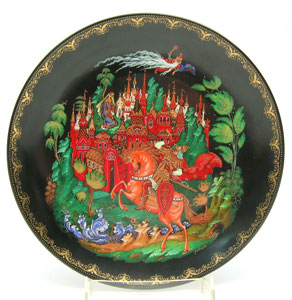A Short History of Russian Fairy Tale Plates
The beginning of the market for Russian-made collector's plates coincided with the breakup of the Soviet Union. In 1988, the first 12 plates produced formed the series RUSSIAN LEGENDS. Manufacture was accomplished in several Soviet/Russian porcelain factories, including the historic Lomonosov Porcelain Factory, and the finished products were sold by The Bradford Exchange under the Tianex imprint. They were easy to manufacture and aggressively marketed as fairly inexpensive investments to a voluminous and over eager group of buyers. The plates were marketed through mail-order subscription, and, on introduction, sold for $29-$35 plus shipping and handling. There was a pent-up demand for Russian-made goods and these colorful plates fit the bill perfectly. As production shot up, later issues came to be made in Lithuania, Belarus and even in the US. (China came last.) The plates were made with up to 17 layers of colored pigments on black porcelain and enhanced with 18kt gold. Eventually over 100 different plates came to be manufactured in a great many series. The artists, unknown in the USA, were famous Russian miniature artists from Palekh, Kholui, and Fedoskino. Each plate was given an individual "Bradex number". Sizes were mostly 7¾" (19cm) in diameter. The backs of each plate carried information in Russian (except for later issues) together with the title and a serial number. Each came in a custom-fitted cardboard (sometimes Styrofoam) box with a Certificate of Authenticity and one or two informational and promotional dual-language brochures in Russian and in English. These handouts were mostly specific to each plate.

The first Russian collector's plate issued in 1988 (3 years before the fall of Communism).
The themes that the artists chose were fairy tales, legends, art, culture, architecture, religion, etc.Some of these were THE RUSSIAN LEGENDS (first, in 1988), THE FIREBIRD (by Lomonosov), THE SNOWMAIDEN, THE SEASONS, VILLAGE LIFE, ORTHODOX CHURCHES, ZHOSTOVO, RUSSIAN ICONS, NUTCRACKER and a few more go-arounds with fairy tales. At the time, it was as if supply would be endless! During the peak of production, as many as 10 different series were being produced at the same time. But eventually, sometime after the year 2000, the frenzied market calmed down and normalized. The earliest issues were produced in the largest quantities, for example, the first plate, "Ruslan and Ludmila", produced in 1988, ran up numbers well into the tens of thousands. When the dust had finally settled, it could be established that these early plates had been produced in large - make that huge - numbers. Some of the last plates in a few of the series are harder to find as Bradford Exchange subscribers became frustrated with the supply and dropped out before completing a full set. Some of the very last series were produced in small, almost test market-size, quantities, making them the hardest to find. And some plates were simply more attractive than others. After all, collector's plates, though voraciously, and perhaps even deceptively, marketed as investments, are, in the final analysis, elegant decorative objects meant to be hung up on a wall and enjoyed.
